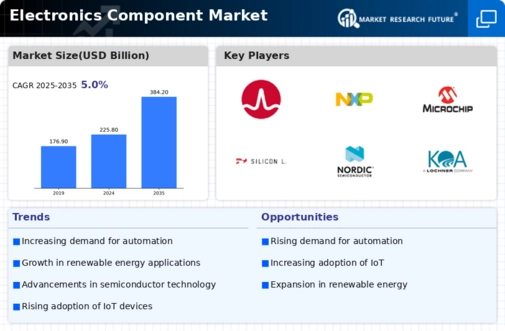Expansion of IoT Applications
The proliferation of Internet of Things (IoT) applications is significantly influencing the Electronic Components Market. As industries increasingly adopt IoT solutions, the demand for components such as connectivity modules, sensors, and processors is expected to rise sharply. By 2025, the IoT market is projected to surpass 1 trillion, with a substantial portion allocated to electronic components. This trend suggests that manufacturers must focus on developing components that are not only efficient but also capable of supporting the vast data exchange inherent in IoT applications. The Electronic Components Industry is thus positioned to benefit from this expansion, as it aligns its offerings with the growing needs of IoT-driven technologies.
Advancements in Automotive Electronics
The integration of electronics in the automotive sector is a pivotal driver for the Electronic Components Market. With the rise of electric vehicles (EVs) and autonomous driving technologies, the demand for sophisticated electronic components is on the rise. In 2025, the automotive electronics market is expected to reach a valuation of over 300 billion, reflecting a compound annual growth rate of around 8%. This growth is largely attributed to the increasing complexity of vehicle systems, which require advanced sensors, microcontrollers, and communication modules. Consequently, the Electronic Components Industry is adapting to these trends by innovating and diversifying their product offerings to cater to the evolving needs of the automotive sector.
Increased Focus on Smart Manufacturing
The trend towards smart manufacturing is reshaping the Electronic Components Industry. As industries adopt automation and data analytics, the demand for advanced electronic components that facilitate these technologies is rising. In 2025, the smart manufacturing market is projected to reach 500 billion, with a significant portion dedicated to electronic components. This shift indicates a need for components that support connectivity, data processing, and real-time monitoring. Manufacturers in the Electronic Components Market are likely to invest in research and development to create products that meet the requirements of smart factories, thereby enhancing operational efficiency and productivity.
Rising Demand for Consumer Electronics
The Electronic Components Market is experiencing a surge in demand driven by the increasing consumption of consumer electronics. As households adopt smart devices, the need for advanced components such as semiconductors and sensors escalates. In 2025, the consumer electronics segment is projected to account for a substantial share of the overall market, with estimates suggesting a growth rate of approximately 6% annually. This trend indicates a robust appetite for innovative products, which in turn propels the demand for high-quality electronic components. Manufacturers are compelled to enhance their production capabilities to meet this growing need, thereby fostering competition and innovation within the Electronic Components Market.
Growth in Renewable Energy Technologies
The shift towards renewable energy sources is emerging as a crucial driver for the Electronic Components Industry. As nations strive to reduce carbon emissions, the demand for solar panels, wind turbines, and energy storage systems is increasing. This transition necessitates a variety of electronic components, including inverters, controllers, and batteries. In 2025, the renewable energy sector is anticipated to grow at a rate of approximately 10%, which will likely stimulate demand for specialized electronic components. This growth presents an opportunity for the Electronic Components Market to innovate and provide solutions that enhance the efficiency and reliability of renewable energy technologies.
















Leave a Comment